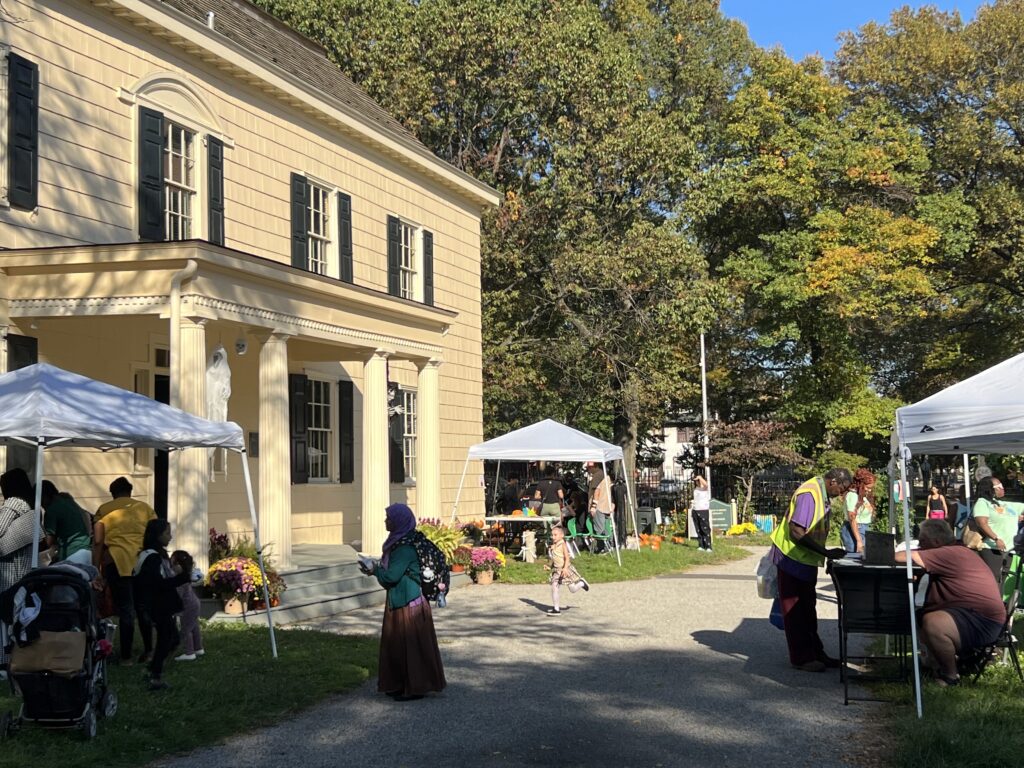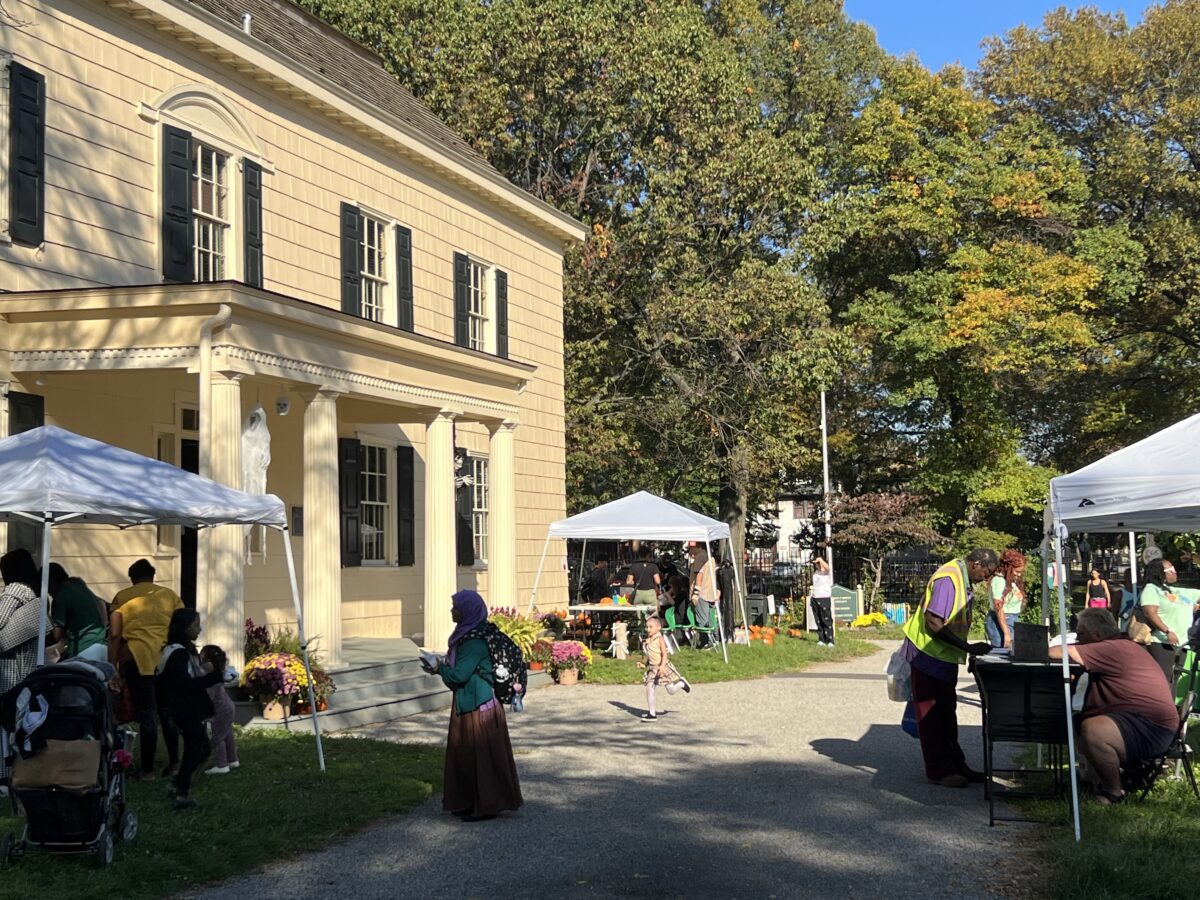Fall Festivities and Fiber Arts at King Manor
By Celia Bernhardt | cbernhardt@queensledger.com
King Manor held their annual Fall Festival on a surprisingly warm, golden Saturday in Jamaica.
The Manor incorporated the second annual Queens Fiber Festival—where artisans specializing in crochet, rug making, yarn dying, and more are invited to set up shop and sell their goods—into their festivities. The Fall Festival also welcomed energy and nonprofit vendors, fiber artisans and entrepreneurs, a crochet workshop, a historic craft beer tasting, tours of the museum, free books, a pumpkin picking station and crafts.
Preserved in the center of a larger park, King Manor is the historic home of Rufus King, a founding father and early anti-slavery advocate. The Manor’s foundation hosts frequent community events, and describes itself as driven by King’s legacy to use education to “promote social change in today’s world.”
In the front yard of the manor, kids swarmed the tables where they were able to craft independently or follow directions to make historic crafts, such as corn husk doll making and Victorian pin making.
Other stations offered free books—many of them courtesy of the Black Resource Network, an organization the Manor partners with—as well as raffle tickets, vendors like Growing Up Green Charter Schools and an affordable pumpkin picking station.
“There’s no pumpkin patch near here,” said Kelsey Brow, Executive Director of King Manor. “So we will have a little one here for our community.”
“There’s a lot of Fall events, but not a whole lot in this community,” Brow continued. “Pretty much everything here is free. The pumpkins are $1 to help support the museum, but everything else is free. Because it’s our mission here to make sure that economic status isn’t the barrier to participation.”
In the backyard, fiber arts vendors—selling largely crochet, but also dyed yarn and related goods—set up their stands in a wide semi-circle to show off their colorful work.
Regina Sawyer, 42, founded the Queens Fiber Festival just last year. “Born and bred” in Queens, she currently lives in Briarwood.
“Last year, I came up with the idea of having a fiber festival in Queens,” she said. “I reached out to the King Manor Museum and asked them if they’d be interested in having an event like this. They said yes…and they asked if it could be incorporated into the Fall Festival. And so we did it for the first time last year and everything just went together seamlessly: like the fall events that were happening for the Fall festival, and for the Fiber Festival, it all just came together really well. So here we are!”
“I thought it’d be a really great idea,” she added, “because there are other fiber festivals in Manhattan and Brooklyn, but nothing in Queens or any of the other boroughs.”
Among the fiber vendors was Hannah Villanueva (artist name Hannah Via), a Sunnyside resident who crafts colorful, handmade rugs and other tufted goods, working from her studio in Astoria. Villanueva said she appreciated the opportunity to sell her artwork in her own borough. “I usually do events that are, like in Manhattan or Brooklyn, you know, more central to the city,” she said. “It’s been very nice to be outside, kind of more in a community setting out in the park and among greenery.”
Camryn Easley, a Bed-Stuy artist who founded a crochet club for Black women and nonbinary people called “Knot Okay,” said the event was a great way to make sales and foster connections with other artisans.
“I found out about this event last year I attended, and then this year, I’m a vendor. So I feel like that’s really cool to have that full circle moment,” Easley said.
“It’s really nice to appreciate other people’s work and also have them, in turn, come and look at your booth. And there’s people who are, you know, dyeing yarn, and then [you can] talk to them about, you know, ‘if you dye the yarn, and then I can crochet something for it.’ So there’s partnerships that come out of it.”
Meanwhile, through a side entrance to the museum, Forest Hills resident Dan Olson, 70 offered a beer-tasting experience unlike any other. Along with two colleagues from his Astoria-based homebrew club “Brewstoria,” Olson offered tastings of historically accurate beer that Rufus King himself might have once enjoyed.
“The three of us are home brewers—we do this as a hobby, nothing commercial,” Olson explained. “And some of us like to go through original recipes or work with unusual non- beer ingredients.”
Made faithfully from a recipe sourced directly from the King Manor archives, the dark, tangy beer served that day was produced with only ginger, molasses, hops, and yeast, lacking the typical base of grain that we associate with beer.
“The recipe was from here. It’s from around 1815…when you look at it, it looks like the wife of the house, who was also the brewer, probably clipped this out of the local magazine and said, ‘I’ll brew this,’ and kept the recipe,” Olson said.
Olson told the history of beer’s development to visitors, explaining that brewing was the woman of the house’s job until commercial production ramped up in the late 1800s.
Kids, parents, and young people circled around and through the manor throughout the afternoon, enjoying the many activities.
“We really want to have something really friendly and welcoming, showing local artists and diverse people with different racial, ethnic and sexual identities, just making it a really welcoming space for everybody here,” Brow said, “It’s just always a cozy environment in these events, so it’s always happy to see all different people here enjoying themselves.”


